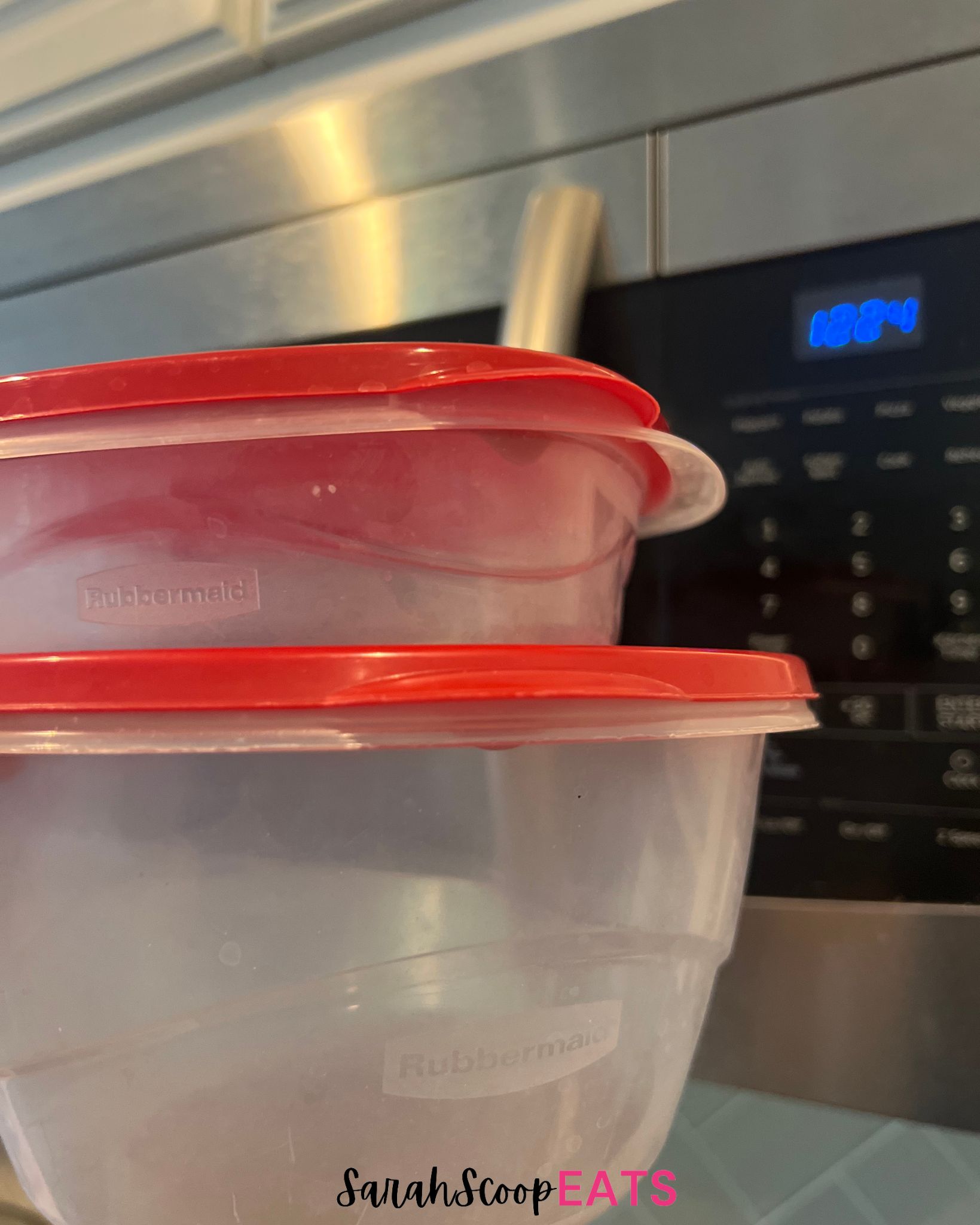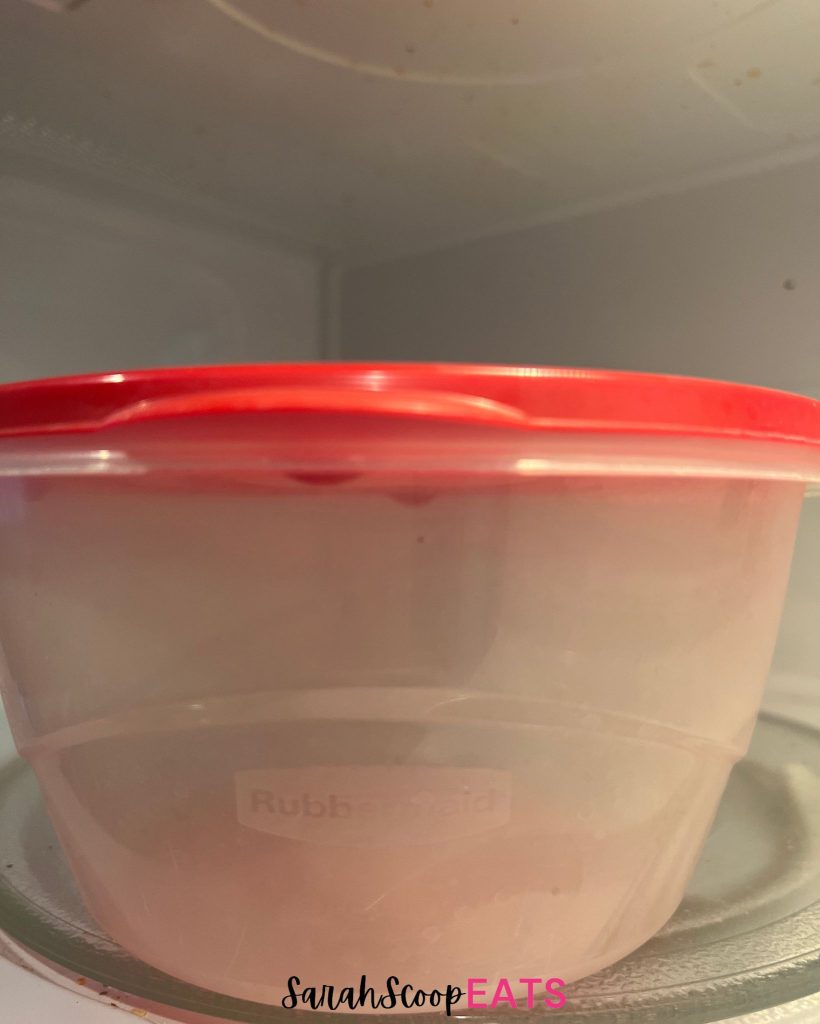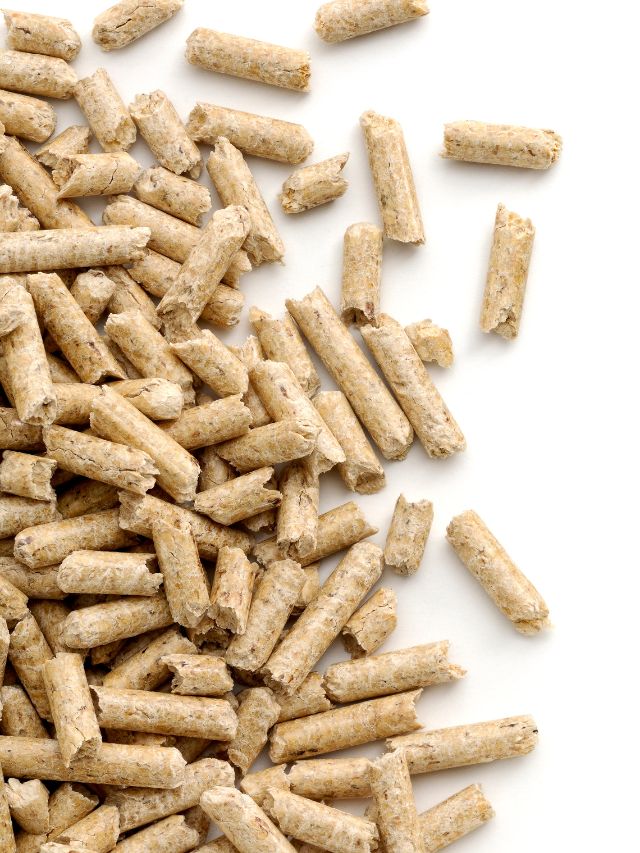Can You Put Rubbermaid in the Microwave

You’re pulling your travel mugs and rubbermaid container out of your lunch box and you think to yourself, can you put Rubbermaid in the microwave? Is my Rubbermaid Tupperware microwave safe?
This is a question that has been asked countless times, especially since Rubbermaid products are common in almost every home.
If you’re not familiar with Rubbermaid Tupperware, we’ll tell you more about it.

Tupperware products like Rubbermaid are plastic Tupperware that can store food and give you peace of mind no matter what types of food you cook.
When it comes to storing and reheating food, many people rely on Rubbermaid containers for their versatility and durability.
These high quality products are very popular in the United States for cold storage, but is it made of microwave-safe plastic?
Rubbermaid might be for normal home use, but is it the best plastic for a microwave? Can you maintain safety standards when using these plastic food storage containers in the microwave?
The quick answer to this question is a qualified yes.
Can You Put Rubbermaid in the Microwave
While, yes you can put Rubbermaid in the microwave, to ensure both the safety of the container and the quality of your reheated food, you must take certain precautions.
Unlike other plastic products, you can use these microwave-safe containers in short bursts.
They come with a microwave symbol as well as a recycling symbol.
But, it’s important to note the unique materials that make up these Tupperware containers come with specific instructions for heating.

Rubbermaid is a well-known manufacturer of high-quality, food-grade plastic containers, tubs, and lids, and their products are typically microwave-safe.
Rubbermaid is one of the types of plastic containers you can put in a microwave oven to heat food without causing harmful chemicals to leak into your food.
However, Rubbermaid products that can’t withstand high microwave temperatures may not be safe to use in the microwave.
This is why it is important to check for the “microwave-safe” label on your container before use.
Most Rubbermaid can withstand temperatures up to 212°F (100°C). This temperature is the boiling point of water, making it one of the safer options for heating.
The best way to microwave Tupperware involves reading the manufacturer’s label, as a general rule since it contains plastic material.
As long as you don’t exceed this limit, your container should be safe! And more importantly, no harmful substances should get into your food.
Safety Tips for Putting Rubbermaid Tupperware in the Microwave
When microwaving Rubbermaid, there are a few safety tips to keep in mind.
Be sure to avoid direct heat when you’re microwaving your hot food.
Also, make sure your old Rubbermaid containers and Rubbermaid lids don’t have any wavy lines from too much heat.
Always lift the lid slightly to allow steam to vent from the container, and remove the lid carefully after microwaving, as steam can escape rapidly and cause serious burns.
If possible, use heat-resistant gloves, as the heat transfer rate of steam is very quick.
Following these simple steps is the easiest way to prolong the life expectancy of your packaging materials.
Your case of Rubbermaid containers can continue acting as the perfect microwave safe food packaging if you follow proper guidelines.
By following these precautions, you can confidently use Rubbermaid containers in the microwave for the convenient storage and reheating of your favorite dishes.
Understanding Rubbermaid Products

Materials Used
When you use your Rubbermaid products it’s important to note what materials you’re using.
Rubbermaid products are made from a variety of materials, including plastic, glass, and ceramic. These materials are chosen for their durability, lightweight nature, and suitability for food storage.
Some plastics might make up single-use containers, but others allow you to microwave food without causing harm or damage.
Many Rubbermaid containers are BPA-free, labeled with a BPA-free sticker.
This ensures that they are safe for customer use and do not contain endocrine disruptors.
Microwave-Safe Symbol
Before using a Rubbermaid in the microwave, check for the microwave-safe symbol and labels.
A Rubbermaid can’t be a great value if it doesn’t have this label.
This symbol indicates that the product has been tested and designed for use in microwave ovens.
Following the instructions provided on the label ensures the safe and efficient heating of your food without compromising the container’s integrity or quality.
Remember, you should keep an eye on the container while microwaving, and avoid exposing it to high temperatures beyond the recommended limit.
By following these safety guidelines, you can confidently and safely use Rubbermaid containers in the microwave.
Rubbermaid Product Lines

Rubbermaid offers a variety of product lines that cater to different needs, such as TakeAlongs and Brilliance.
- TakeAlongs: This line is designed for on-the-go food storage and is made of lightweight plastic materials. These containers are perfect for lunches, snacks, or meal prep. And can be microwaved up to 212°F (100°C) with a closed, vented lid.
- Brilliance: The Brilliance line features containers made from a combination of glass and plastic. This offers a more durable and elegant solution for food storage. These containers are also microwave-safe, allowing for easy reheating of your meals without the risk of damaging the container.
Make sure you choose the item line that fits you and your family’s needs.
But, with whatever line you choose, do your research and know the limits of each Rubbermaid product.
When using Rubbermaid products in the microwave, it’s crucial to follow the manufacturer’s guidelines provided on the packaging or product literature to ensure safe and proper use.
Safety Guidelines for Microwaving Rubbermaid Containers
Temperature Limits
Rubbermaids are generally considered safe to use when microwaving, but it is essential to adhere to specific temperature guidelines when doing so.
They are designed to withstand temperatures up to 212°F (100°C), which is the boiling point of water.
The glass portions of Rubbermaid are also made of microwave-safe glass. This means even when you’re using glass Rubbermaid food containers, they’ll still work in the microwave.
A good idea is to make sure the variety of storage containers you bought can withstand these temperatures before use.
The electromagnetic radiation from microwaves might damage other commercial products, but the good news is that Rubbermaid can potentially avoid this.
Heating the containers beyond this limit may cause melting or deformation during microwave use.
Therefore, avoid microwaving fatty, oily, or sugary foods that can reach higher temperatures and may damage the container.
Ventilation and Steam

When microwaving Rubbermaid containers, it’s crucial to allow proper ventilation and steam escape.
Some Rubbermaid food storage containers come with a microwave-safe base and vented lids, creating smooth heat transfer and preventing pressure build-up.
You can also use mylar foil lids with holes to assist the steaming process in your
Always follow the manufacturer’s instructions for optimal safety while reheating food with a closed lid.
Labels and Symbols
Check for a label before you microwave Rubbermaid to ensure you’re using the right type of plastic, and more importantly, you’re microwaving your amount of food the safe way.
Safe Rubbermaid containers are made from a special formulation of high-quality plastics declared safe by the drug administration.
Some materials include high-density polyethylene, polystyrene foam, and more, which, according to scientific studies, don’t cause hormonal imbalances if food is microwaved with it.
You can usually find this symbol on the bottom or side of the container.
You should always make sure to check for this label to ensure the safe heating of your food in Rubbermaid containers.
Effects of Microwaving Rubbermaid Containers on Food

Reheating and Defrosting
Popping your leftovers in the microwave straight out of your Rubbermaid is just so quick and easy!
Instead of having to do extra dishes by taking out bowls and plates, you have the option to just use what the food was already stored in.
Who wouldn’t want to take the easy way out?
But, if you’re going to use your Rubbermaid to reheat or defrost, there are some important things to note.
Using Rubbermaid containers for reheating and defrosting food in the microwave is generally considered safe.
The containers are designed to withstand temperatures up to 212°F (100°C), which should be sufficient for most reheating and defrosting needs.
When using Rubbermaid containers in the microwave, it is essential to ensure proper ventilation by lifting the lid slightly or using a vented lid, as steam can vent and cause burns if not properly managed.
Cooking with Fats, Sugars, and Salts
It is important to consider the contents of the food being microwaved in Rubbermaid containers:
- Fats and Oils: Rubbermaid advises against microwaving fatty foods with high fat or oil content, as these can become extremely hot and may damage the container or pose a safety risk. A possible alternative is to use only low to medium heat settings, which may reduce the chances of damaging your container.
Alternatives and Additional Food Storage Options
In this section, we will discuss alternative options for food storage containers, focusing on glass and ceramic containers, as well as Tupperware and other brands.
Glass and Ceramic Containers
Glass and ceramic containers are popular alternatives to plastic food storage options due to their higher durability and heat resistance.
They are generally microwave-safe, and you can even find some options like the Rubbermaid Brilliance Glass Storage Food Containers that combine the quality of glass containers with the convenience of a leak-proof, BPA-free plastic lid.
These containers are also dishwasher and oven-safe, making them versatile kitchenware.
One of the main benefits of glass and ceramic containers is that they do not absorb odors or release chemicals when heated, unlike some plastic materials.
However, they can be heavier and more fragile compared to their plastic counterparts.
Stainless steel and other metals, on the other hand, shouldn’t be used in the microwave, as the squiggly lines from the radiation can cause warping.
Tupperware and Other Brands
When you think of food storage Tupperware is the first thing that comes to mind for many people.
Tupperware is a well-known brand in the food storage container market.
Its products are typically made from polypropylene and polystyrene materials. As you may know, these materials are BPA-free and microwave-safe.
Rubbermaid is another reputable brand that produces microwave-safe, BPA-free containers with vented lids, allowing for safe and convenient reheating of food.
BPA free means it doesn’t contain bisphenol A or any other BPAs like polyvinyl chloride.
Tips on Finding the Best Food Containers
To help you find the best option for your needs, here are a few key features to consider when searching for food storage containers:
- Lids: Look for containers with tight-fitting, leak-proof lids to prevent spills and maintain freshness.
- Stackable: Opt for stackable containers to maximize storage space in your fridge or pantry.
- Material: Choose between glass, ceramic, or plastic materials depending on your preference for durability, heat resistance, and weight.
- Microwave-safe: Ensure the containers are microwave-safe for quick and easy reheating.
- Size: Select a size that works best for your food storage needs, a 4-cup container is a common size.
By considering these factors, you can find the perfect food storage solution to suit your needs and maintain a well-organized kitchen.
Putting Your Rubbermaid in the Microwave
After reading this, you have surely seen that there are many things to consider when putting your Rubbermaid in the microwave.
From the temperature to the proper ventilation process, there are a few things you should look into before throwing your Rubbermaid in the microwave.
With our helpful tips, you should be able to reheat those tasty leftovers in your Rubbermaid in no time.
Whether it’s for a quick snack or a family dinner, enjoy your meal and keep on using Rubbermaid as your go-to food storage container.
So, overall when asking the question, is my Rubbermaid microwave safe? The answer is yes!

Get the scoop on more like this:






